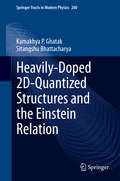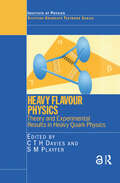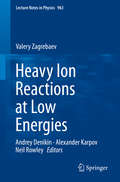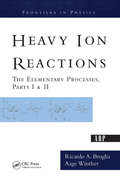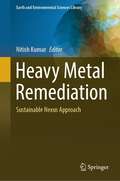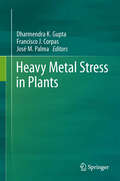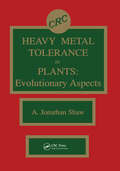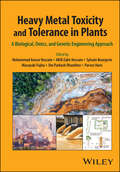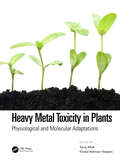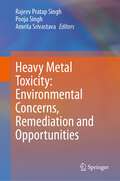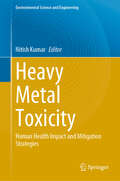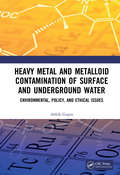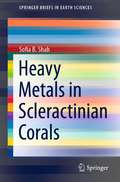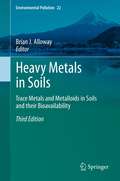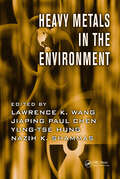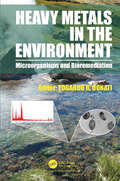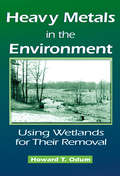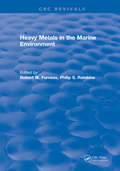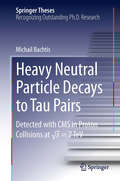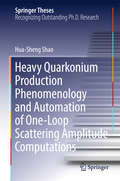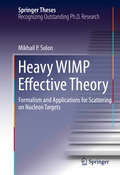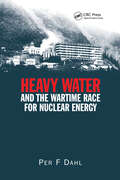- Table View
- List View
Heavily-Doped 2D-Quantized Structures and the Einstein Relation
by Sitangshu Bhattacharya Kamakhya P. GhatakThis book presents the Einstein Relation(ER) in two-dimensional (2-D) Heavily Doped (HD) Quantized Structures. The materials considered are quantized structures of HD non-linear optical, III-V, II-VI, Ge, Te, Platinum Antimonide, stressed materials, GaP, Gallium Antimonide, II-V, Bismuth Telluride together with various types of HD superlattices and their Quantized counterparts respectively. The ER in HD opto-electronic materials and their nanostructures is studied in the presence of strong light waves and intense electric fields on the basis of newly formulated electron dispersion laws that control the studies of such quantum effect devices. The suggestion for the experimental determination of HD 2D and 3D ERs and the importance of measurement of band gap in HD optoelectronic materials under intense built-in electric field in nanodevices and strong external photo excitation (for measuring photon induced physical properties) are also discussed in this context. The influence of crossed electric and quantizing magnetic fields on the ER of the different 2D HD quantized structures (quantum wells, inversion and accumulation layers, quantum well HD superlattices and nipi structures) under different physical conditions is discussed in detail. This monograph contains 100 open research problems which form the integral part of the text and are useful for both Ph. D aspirants and researchers in the fields of condensed matter physics, solid-state sciences, materials science, nano-science and technology and allied fields.
Heavy Drinking
by Herbert FingaretteThinking of heavy drinking as something other than a disease may, the author suggests, be helpful to many heavy drinkers. Interesting to alcohol over-users and those who know them.
Heavy Flavour Physics Theory and Experimental Results in Heavy Quark Physics (Scottish Graduate Ser.)
by C Davies S M PlayferThis book provides a thorough introduction to the phenomenology of heavy flavour physics, those working on the B-factories, LHCb, BTeV, HERA and the Tevatron. It explains how heavy quark theory could be implemented on the lattice, and discusses the status of CP-violation in the neutral kaon system.
Heavy Ion Reactions at Low Energies (Lecture Notes in Physics #963)
by Valery ZagrebaevThis book is based on Valery Zagrebaev's original papers and lecture materials on nuclear physics with heavy ions, which he prepared and extended through many years for the students of nuclear physics specialties.Thе book outlines the main experimental facts on nuclear reactions involving heavy ions at low energies. It focuses on discussions of nuclear physics processes that are a subject of active, modern research and it gives illustrative explanations of these phenomena in the framework of up-to-date theoretical concepts.This textbook is intended for students in physics who have completed a standard course of quantum mechanics and have basic ideas of nuclear physics processes.It is designed as a kind of lifeboat that, at the end of the course, will allow students to navigate the modern scientific literature and to understand the goals and objectives of current, on-going research.
Heavy Ion Reactions: The Elementary Processes, Parts I&II (Frontiers in Physics #Vol. 84)
by Ricardo A. BrogliaCombining elastic and inelastic processes with transfer reactions, this two-part volume explores how these events affect heavy ion collisions. Special attention is given to processes involving the transfer of two nucleons, which are specific for probing pairing correlations in nuclei. This novel treatment provides, together with the description of surface vibration and rotations, a unified picture of heavy ion reactions in terms of the elementary modes of nuclear excitation. Heavy Ion Reactions is essential reading for beginning graduate students as well as experienced researchers.
Heavy Metal Contamination in the Environment: Health Impacts and Potential Remediation Approaches
by Ashish Kumar Vishal Mishra Sachchida Nand Rai Veer SinghThis reference book explores the multifaceted problem of heavy metal contamination in the environment. Through its in-depth analysis, the book provides a thorough overview of the sources and pathways of heavy metals, their persistence in ecosystems, and the resulting health impacts on individuals and ecosystems. The chapters explore the diverse sources of contamination, including industrial activities, mining, agriculture, and urbanization, while examining the types of heavy metals found in the environment and their toxicological properties. The book further reviews the profound health effects associated with heavy metal exposure, such as neurological disorders, developmental abnormalities, carcinogenicity, and organ damage. Furthermore, the book provides insights into risk assessment methodologies, regulatory frameworks, and guidelines aimed at controlling and minimizing heavy metal exposure. It highlights the challenges and gaps in current regulations, identifies potential areas for improvement, and presents analytical techniques for heavy metal analysis and removal. This book is an important source for researchers and professionals working in the fields of environmental science, toxicology, and public health.
Heavy Metal Remediation: Sustainable Nexus Approach (Earth and Environmental Sciences Library)
by Nitish KumarHeavy metals, in general trace elements, are one of the major environmental problems. Nowadays, increasing environmental and global public health concerns related with environmental contamination by heavy metals are well known. Moreover, human exposure has risen dramatically because of an exponential increase of their use in several activities such as agricultural, industrial, technological and urban applications. They are presented in soils, water and atmosphere and they are a serious risk for the food chain.Approximately 10 million contaminated sites have been reported globally, occupying approximately 49.42 million acres of land, of which >50% is contaminated with toxic heavy metals. This situation warrants immediate attention to limit the introduction of heavy metals into soil systems and to remove the prevailing heavy metals from polluted soils. However, the majorities of existing heavy-metal-removal technologies are expensive, inefficient, or generate secondary pollutants. Therefore, it is of great importance to develop cheaper, environmentally friendly and sustainable approaches (including the development of new immobilizing agents) to manage and rehabilitate heavy-metal-contaminated soils. In the light of the aforementioned facts, this book sheds light on this global environmental issue, and proposes solutions to contamination through multi-disciplinary approaches and case studies from different parts of the world. It addresses sustainable heavy metal contamination remediation strategies using the potential applications of recent biological technology such as biotechnology, bioremediation, phytoremediation, biochar, absorbent, genetic engineering, and nanotechnology approaches. This book is of interest to researchers, teachers, environmental scientists, environmental engineers, environmentalists, and policy makers. Also, the book serves as additional reading material for undergraduate and graduate students of environmental microbiology, biotechnology, eco-toxicology, environmental remediation, waste management, and environmental sciences as well as the general audience.
Heavy Metal Stress in Plants
by Francisco J. Corpas Dharmendra K. Gupta José M. PalmaPlants possess a range of potential cellular mechanisms that may be involved in the detoxification of heavy metals and thus tolerance to metal stress. Metal toxicity causes multiple direct and indirect effects in plants that concern practically all physiological functions. The main purpose of this book is to present comprehensive and concise information on recent advances in the field of metal transport and how genetic diversity affects heavy metal transport in plants. Other key futures of the book are related to metal toxicity and detoxification mechanisms, biochemical tools for HM remediation processes, molecular mechanisms for HM detoxification, how metallomics and metalloproteomics are affected by heavy metal stress in plants, and the role of ROS metabolism in the alleviation of heavy metals. Some chapters also focus on recent developments in the field of phytoremediation. Overall the book presents in-depth information and the most essential advances in the field of heavy metal toxicity in plants in recent years.
Heavy Metal Tolerance in Plants: Evolutionary Aspects
by Jonathan ShawThis volume provides a synthesis of recent work on evolutionary aspects of metal tolerance in plants. It presents contributions from scientists with a wide diversity of expertise. It covers the evolution of heavy metal tolerance in groups of plants, fungi, and protists. The book discusses the physiological, genetic and molecular aspects of metal tolerances. It deals with the evolution of populations in metal-contaminated environments. Several chapters include tolerance in animals in order to place the rest of the book on plants in proper perspective. This publication is an exciting addition for scientists with both applied and basic interest in metal toxicity and tolerance. It is of importance to those in vegetation ecology, land reclamation, agronomy, physiology, population ecology, ecological genetics, evolutionary biology and molecular biology.
Heavy Metal Toxicity and Tolerance in Plants: A Biological, Omics, and Genetic Engineering Approach
by Om Parkash Dhankher Masayuki Fujita Mohammad Anwar Hossain Sylvain Bourgerie Parvez Haris Akm Zakir HossainComprehensive resource detailing the molecular mechanisms underlying heavy metal toxicity and tolerance in plants Heavy Metal Toxicity and Tolerance in Plants provides a comprehensive overview of the physiological, biochemical, and molecular basis of heavy metal tolerance and functional omics that allow for a deeper understanding of using heavy metal tolerance for deliberate manipulation of plants. Through the authors’ unique approach, the text enables researchers to develop strategies to enhance metal toxicity and deficiency tolerance as well as crop productivity under stressful conditions, in order to better utilize natural resources to ensure future food security. The text presents the basic knowledge of plant heavy metal/metalloid tolerance using modern approaches, including omics, nanotechnology, and genetic manipulation, and covers molecular breeding, genetic engineering, and approaches for high yield and quality under metal toxicity or deficiency stress conditions. With a collection of 26 chapters contributed by the leading experts in the fields surrounding heavy metal and metalloids toxicity and tolerance in crop plants, Heavy Metal Toxicity and Tolerance in Plants includes further information on: Advanced techniques in omics research in relation to heavy metals/metalloids toxicity and tolerance Heavy metals/metalloids in food crops and their implications for human health Molecular mechanisms of heavy metals/metalloids toxicity and tolerance in plants Molecular breeding approaches for reducing heavy metals load in the edible plant parts Hormonal regulation of heavy metals toxicity and tolerance Applications of nanotechnology for improving heavy metals stress tolerance Genetic engineering for heavy metals/metalloids stress tolerance in plantsWith comprehensive coverage of the subject, Heavy Metal Toxicity and Tolerance in Plants is an essential reference for researchers working on developing plants tolerant to metals/metalloids stress and effective strategies for reducing the risk of health hazards.
Heavy Metal Toxicity in Plants: Physiological and Molecular Adaptations
by Khalid Rehman Hakeem Tariq AftabHeavy Metal Toxicity in Plants: Physiological and Molecular Perspectives highlights the various metal induced impacts on plants and adaptation strategies employed to avoid these stressful conditions. The volume comprise the chapters from the different areas ranging from latest biotechnological to omics approaches. This comprehensive volume emphasizes on the recent updates about the current research on the heavy metal stress in plant biology covering different aspects related to challenges and opportunities in the concerned field. This book is an attempt to bring together researchers who have been engaged in the area of stress signaling, crosstalk and mechanisms of heavy metal stress and share their research findings. Various chapters deal with the topics ranging from sensing and signalling in plants to translational research. The book will provide a direction towards implementation of programs and practices that will enable sustainable production of crops, resilient to environmental heavy metal pollution. Features: The book covers the heavy metal impact on plants in detail. Chapters cover an array of topics and issues related to heavy metal pollution and its management strategies by plants Recent research results and some pointers to future advancements in current topic.
Heavy Metal Toxicity: Environmental Concerns, Remediation and Opportunities
by Rajeev Pratap Singh Pooja Singh Amrita SrivastavaThis contributed volume covers a comprehensive account of the sources, toxic biological as well as environmental impacts, and possible remediation strategies for contamination by heavy metals. In biological systems, toxic metals affect the integrity of cellular organelles and act as carcinogens causing chromosomal aberrations or as systemic toxicants leading to cardiovascular, neurobehavioral, and immunological disorders. In plants, they interfere with photosynthesis, fertility, metabolite, and chlorophyll synthesis. Toxicity induced by heavy metals involves mechanistic approaches that need to be understood properly. They cannot be degraded by biological or chemical means and thus can only be converted to less harmful forms. The conventional detection methods include biosensors, voltammetry, atomic absorption spectrometry, and inductively coupled plasma with atomic emission spectrometry. All such strategies for metal detection and mitigation strategies are covered in this title under one section. This book incorporates classical views along with modern scientific approaches to develop an understanding of the subject matter suitable for academicians, researchers, planners, policymakers, NGOs, and environmental consultancies and raise awareness on this concern. Topics representing diverse sections namely environmental impacts, biological effects, and methods used for detection and remediation have been included to address all possible contemporary issues on the topic in one concise volume.
Heavy Metal Toxicity: Human Health Impact and Mitigation Strategies (Environmental Science and Engineering)
by Nitish KumarThis edited book brings together a diverse group of environmental science, sustainability, and health researchers to address the challenges posed by global mass poisoning caused by heavy metals contamination of soil and plants. In recent years, contamination of the environment by heavy metals has become a major concern. Their multiple industrial, domestic, agricultural, medical, and technological applications have led to their wide distribution in the environment, raising concerns over their potential effects on human health and the environment. Owing to their toxic, non-degradable, and bio-accumulative nature, the health burden on the population has increased significantly. Heavy metals such as arsenic, lead, mercury, cadmium, and uranium do not play a significant role in metabolism in the human body and are thus toxic. Their exposure in high concentration can cause acute toxicity resulting in acute health conditions, which is easy to observe and regulate, while similar is not visible for immediate action when their exposure is in trace amounts over the years. Heavy metals enter in the food chain through consumption of plant material. A high concentration of heavy metals has been found to be harmful to vegetation. As the heavy metals concentration in plants increases, it adversely affects several biological parameters and eventually renders the soil barren.The book sheds light on this global environmental issue and proposes solutions to contamination through multi-disciplinary approaches and case studies from different parts of the world. This book is a valuable resource to students, academicians, researchers, and environmental professionals who are doing field work on heavy metals contamination throughout the world.
Heavy Metal and Metalloid Contamination of Surface and Underground Water: Environmental, Policy and Ethical Issues
by Abhik GuptaHeavy metal and metalloid contamination of groundwater and surface water ecosystems involves important policy-related and ethical issues besides its more well-known scientific aspects. Heavy Metal and Metalloid Contamination of Surface and Underground Water: Environmental, Policy, and Ethical Issues has brought these three dimensions under a single volume. The book presents an updated status of the nature and extent of heavy metal and metalloid contamination of water and discuss its future implications. In Section I, the book provides a state-of-the-art review of research findings on entry, storage, and release, human health risks, and the uptake and accumulation by freshwater biota and the toxic effects experienced by them. The book also provides information on the bioremediation of heavy metals and metalloids, and the possible effects of climate change on their distribution and toxicity. Section II of the book throws light on the policies and legislations adopted in several countries to deal with the vexed issue of metal contamination of waters in both historical and current perspectives. Special emphasis has been given to the contamination of drinking water and its attendant implications for human health. The book also treats the relevance and applications of Integrated Water Resources Management (IWRM), which forms the backbone of the water policies of several countries. In Section III, discussions focus on ethical issues rising out of heavy metal and metalloid contamination of water, and on the different ethical approaches and principles in both indigenous and other societies. Features: A systematic overview of the major facets of heavy metal and metalloid contamination of water Compilation and analysis of the latest research in the subject area Ample case studies in all chapters that highlight specific problems Review of policy and legislation for the control of heavy metal pollution of water Water ethics in indigenous societies This book will be a vital resource for students and research scholars in the field of environmental science, ecotoxicology, and pollution studies.
Heavy Metal and You
by Christopher KrovatinSam wears spiked bracelets, gets wasted with his friends, and has almost encyclopedic knowledge about heavy-metal music. But he's also incredibly intelligent and as knowledgeable about classic literature as he is about the music he loves. Sam attends an expensive all-boys prep school in New York City, and he and his buddies often cut classes to smoke or get an early start on the weekend. But all good things must end, and they do with a sudden crash when Sam begins to date Melissa, a straightedge who doesn't drink or do drugs and doesn't like the fact that he does. Sam tries to modify his behavior for the girl who is more important to him than he ever thought possible, but pleasing Melissa means completely changing who he is. This romance is chock-full of music references, slang, and general metalhead band knowledge such as album release dates, etc. The language is raw and full of sexual talk and innuendo, especially among Sam and his friends. The main characters are well developed and mostly believable, if a bit more emotional than expected on Sam's part. The plot moves quickly and jumps from past to present, with Sam interspersing his current situation with relevant scenes from his past. This rapid progression, as well as the realistic situations and language, keep teens' attention, making the book a good choice for reluctant readers.
Heavy Metals in Scleractinian Corals (SpringerBriefs in Earth Sciences)
by Sofia B. ShahThis book provides an in-depth review of heavy metals in corals, describing the sources of heavy metals in the marine environment and their effect on corals. It is designed to serve as a unique reference for upcoming marine researchers and chemists, advanced undergraduate and postgraduate students as well as those interested in marine pollution with respect to heavy metals. The book explains the basics as well as the state-of-the-art regarding heavy metals and corals and is engaging and clearly written and narrated, providing readers with the fundamental tools about the subject matter that they need in their specific fields. It allows readers to understand and appreciate the interactions between the atmosphere, ocean, and the geosphere. Detailed reference is included for the benefit of the reader. The specific objectives of this book are (i) to inform/educate the reader about persistent pollutants such as heavy metals, (ii) to identify sources of heavy metals in the marine environment, (iii) to inform about route of exposure and uptake of the heavy metal pollutants by corals, (iv) to elaborate about the effect of heavy metal pollutants on the coral reef ecosystems, (v) to discuss the ways in which heavy metal regulation occurs in corals, (vi) to impact current knowledge regarding heavy metals in the marine environment, and (vii) to briefly show chemical analysis and instrumentation for analyzing heavy metals.
Heavy Metals in Soils: Trace Metals and Metalloids in Soils and their Bioavailability
by Brian J. AllowayThis third edition of the book has been completely re-written, providing a wider scope and enhanced coverage. It covers the general principles of the natural occurrence, pollution sources, chemical analysis, soil chemical behaviour and soil-plant-animal relationships of heavy metals and metalloids, followed by a detailed coverage of 21 individual elements, including: antimony, arsenic, barium, cadmium, chromium, cobalt, copper, gold, lead, manganese, mercury, molybdenum, nickel, selenium, silver, thallium, tin, tungsten, uranium, vanadium and zinc. The book is highly relevant for those involved in environmental science, soil science, geochemistry, agronomy, environmental health, and environmental engineering, including specialists responsible for the management and clean-up of contaminated land.
Heavy Metals in the Environment (Advances in Industrial and Hazardous Wastes Treatment)
by Lawrence K. Wang Yung-Tse Hung Nazih K. Shammas Jiaping Paul ChenA successful modern heavy metal control program for any industry will include not only traditional water pollution control, but also air pollution control, soil conservation, site remediation, groundwater protection, public health management, solid waste disposal, and combined industrial-municipal heavy metal waste management. In fact, it should be
Heavy Metals in the Environment: Microorganisms and Bioremediation
by Edgardo R. DonatiThis book serves as a knowledge bank for researchers and graduate students in microbiology, chemistry, and environmental sciences, among others. It focuses on heavy metal in the environment and describes methodologies to immobilize and mobilize heavy metals. It also provides case studies which may be of particular interest to persons in industry.
Heavy Metals in the Environment: Using Wetlands for Their Removal
by Howard T. Odum Lowell Pritchard Wlodzimierz Wójcik Shanshin Ton Joseph J. Delfino Malgorzata Wójcik Slawomir Leszczynski Jay D. Patel Steven J. Doherty Jacek StasikMuch of the convenience of modern life resides in sheet metal, the cowling shield of most machines and appliances. However, the load that this takes off human shoulders has to be carried elsewhere, and the Earth has borne the burden. Many of us woke up to the environmental cost when over a century of industrialization finally surpassed the capacity
Heavy Metals in the Marine Environment
by Robert W. FurnessThe aim of this volume is to draw together state-of-the-art reviews of knowledge onlevels of heavy metals in marine environments (particularly in marine animals), the dynamicprocesses in these systems, toxic effects, and threats presented by heavy metals in foods ofmarine origin.All heavy metals, whether biologically essential or not, have the potential to be toxicto organisms at a threshold bioavailability. Such threshold concentrations vary betweenmetals, between species and with the physicochemical characteristics of the medium, somelike copper being particularly toxic even though essential in trace amounts. Responses ofanimals to metals in their medium or food depend to a large extent on the ability of speciesto regulate levels attained in their tissues. Higher animals have the capacity to regulate levelsof many metals, while marine invertebrates can regulate some within certain limits. Whereanimals cannot regulate physiological levels of metals, an alternative strategy is to detoxifyand store metals in relatively harmless forms. Knowledge of the manner in which animals deal with potentially toxic concentrations of heavy metals is of fundamental importance in the assessment of metal pollution by analysis of metal levels in biological samples. The interaction of heavy metals with biological materials is a key theme running through this volume. Toxic effects may be reflected at the individual, population, or ecosystem level, affecting species composition and production levels, or may be of direct dietary significance to man. The global cycling of metals through the marine environment is crucially affected by biological processes.
Heavy Neutral Particle Decays to Tau Pairs
by Michail BachtisThe work presented in this thesis spans a wide range of experimental particle physics subjects, starting from level-1 trigger electronics to the final results of the search for Higgs boson decay and to tau lepton pairs. The thesis describes an innovative reconstruction algorithm for tau decays and details how it was instrumental in providing a measurement of Z decay to tau lepton pairs. The reliability of the analysis is fully established by this measurement before the Higgs boson decay to tau lepton pairs is considered. The work described here continues to serve as a model for analysing CMS Higgs to tau leptons measurements.
Heavy Quarkonium Production Phenomenology and Automation of One-Loop Scattering Amplitude Computations
by Hua-Sheng ShaoThis book focuses on the study of heavy quarkonium production at high-energy colliders as a useful tool to explain both the perturbative and non-perturbative aspects of quantum choromodynamics. It provides the first comprehensive comparison between the theory and recent experiments and clarifies some longstanding puzzles in the heavy quarkonium production mechanism. In addition, it describes in detail a new framework for implementing precise computations of the physical observables in quantum field theories based on recently developed techniques. It can be used to simulate the complicated collider environment of the Large Hadron Collider at the Conseil Européen pour la Recherche Nucléaire (CERN). Its accomplishment implies that the Monte Carlo simulations for high-energy physics experiments have reached the limits of precision. It offers readers a wealth of valuable information on the relevant techniques.
Heavy WIMP Effective Theory
by Mikhail P. SolonThis book is about dark matter's particle nature and the implications of a new symmetry that appears when a hypothetical dark matter particle is heavy compared to known elementary particles. Dark matter exists and composes about 85% of the matter in the universe, but it cannot be explained in terms of the known elementary particles. Discovering dark matter's particle nature is one of the most pressing open problems in particle physics. This thesis derives the implications of a new symmetry that appears when the hypothetical dark matter particle is heavy compared to the known elementary particles, a situation which is well motivated by the null results of searches at the LHC and elsewhere. The new symmetry predicts a universal interaction between dark matter and ordinary matter, which in turn may be used to determine the event rate and detectable energy in dark matter direct detection experiments. The computation of heavy wino and higgsino dark matter presented in this work has become a benchmark for the field of direct detection. This thesis has also spawned a new field of investigation in dark matter indirect detection, determining heavy WIMP annihilation rates using effective field theory methods. It describes a new formalism for implementing Lorentz invariance constraints in nonrelativistic theories, with a surprising result at 1/M^4 order that contradicts the prevailing ansatz in the past 20 years of heavy quark literature. The author has also derived new perturbative QCD results to provide the definitive analysis of key Standard Model observables such as heavy quark scalar matrix elements of the nucleon. This is an influential thesis, with impacts in dark matter phenomenology, field theory formalism and precision hadronic physics.
Heavy Water and the Wartime Race for Nuclear Energy
by Per F DahlHeavy water (deuterium oxide) played a sinister role in the race for nuclear energy during the World War II. It was a key factor in Germany's bid to harness atomic energy primarily as a source of electric power; its acute shortage was a factor in Japan's decision not to pursue seriously nuclear weaponry; its very existence was a nagging thorn in the side of the Allied powers. Books and films have dwelt on the Allies' efforts to deny the Germans heavy water by military means; however, a history of heavy water has yet to be written.Filling this gap, Heavy Water and the Wartime Race for Nuclear Energy concentrates on the circumstances whereby Norway became the preeminent producer of heavy water and on the scientific role the rare isotope of hydrogen played in the wartime efforts by the Axis and Allied powers alike. Instead of a purely technical treatise on heavy water, the book describes the social history of the subject.The book covers the discovery and early uses of deuterium before World War II and its large-scale production by Norsk Hydro in Norway, especially under German control. It also discusses the French-German race for the Norwegian heavy-water stocks in 1940 and heavy water's importance for the subsequent German uranium project, including the Allied sabotage and bombing of the Norwegian plants, as well as its lesser role in Allied projects, especially in the United States and Canada. The book concludes with an overall assessment of the importance and the perceived importance of heavy water for the German program, which alone staked everything on heavy water in its quest for a nuclear chain reaction.
